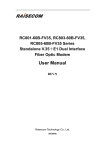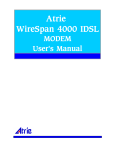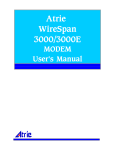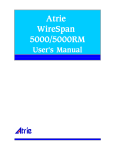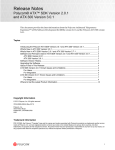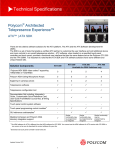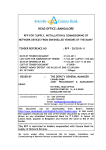Download Atrie WireSpan 600/610
Transcript
Atrie WireSpan 600/610 MODEM User's Manual WireSpan 600 / 610 Fractional E1 Access Unit Installation and Operation manual CONTENTS CHAPTER 1 Interduction………………………….. 1-1 CHAPTER 2 Installation and Setup……………….. 2-1 CHAPTER 3 Operation……………………………. 3-1 CHAPTER 4 Troubleshooting & Diagnostics…….. 4-1 APPENDIX A Interface Specification………………. A-1 MENU TREE ………………………………………. B-1 CHAPTER 1 Introduction 1.1 Overview WireSpan 600 is a cost-effective, single-port fractional E1 access unit. The fractional E1 service makes unused time slots on long-range E1 trunks available for other users. WireSpan 600 provides a synchronous data channel that supports user-selectable transmission rates. The available data rates are integer multiples of 64 kbps; the multiples range is 1 through 32, corresponding to a maximum of 2048 kbps. The user’s payload data is packed in the corresponding number of time slot of an E1 (CEPT 2.048 Mbps) data stream, for transmission over public or private E1 networks. Versions WireSpan 600 is available on two models: z WireSpan 600 – fractional E1 access unit, for applications that integer multiples of 64kbps range from 1 through 32, corresponding to a maximum of 2048 kbps. z WireSpan 610 – Unframed only, for applications that fix 2048M bps data rate. Applications Figure 1-1 shows a typical WireSpan 600 / 610 applications 1-1 E1Transmission Transmission E1 Facilities Facilities N x 64K Rounte r Router N x 64K Converter WireSpan 600 Rounte Router r Converter600 WireSpan RxDRXD N x 64K Terminal Terminal WireSpan 600 Converter N x 64K FE1 WireSpan 600 Converter E1 MUX. E1 Mux. Sub-E1 DSL Line Rounte WireSpan r 3000 N x 64K WireSpan 600 Converter TXD Converter WireSpan 600 TxD WS5000B(LAN) LAN WireSpan WireSpan 5000B5000V V.35 Version N x 64K WireSpan 600 Converter Cascades mode Cascaded PBX PBX Figure 1-1. Typical Wirespan 600 Application Features z z z z z z z z E1 or fractional E1 access unit Support one digital data port Selectable sync data rates of n x 64 kbps,up to 2048 kbps V.35, RS-530, RS-449 or X.21 data interfaces Framing format : PCM31, PCM30 – with or without CRC-4 Zero suppression : AMI, HDB3 E1 interface complies with : ITU G.703, G.704, G.732, G.823, G.706 Unframed over E1 Options WireSpan 600 is available with the following option: z 90 – 120 or 230V( 10%),47-63 Hz Adapter z DTE or DCE data port changeable cable z WireSpan 610 is simple version with unframed mode 1.2 Physical Description WireSpan 600 / 610 are designed for desktop installation. Installation procedures for the WireSpan 600 / 610 models and respective versions are provided in Chapter 2, Installation and Setup. 1-2 Top Panel LED’s The LED indicators on the top panel (see Figure 1-2) indicate the operating status of WireSpan 600. Various indicators display status of E1 or data port, alert conditions, work mode. Figure 1-2. General View Connectors The power and interface connectors are located on the lateral panel of WireSpan 600 / 610. A description of the lateral panel can be found in interfaces and connectors. 1.3 Functional Description WireSpan 600 / 610 has a synchronous user’s data port interface. The electrical interface is user-selectable. The user’s data port is terminated in a 50-pin SCSI-type female connector. ITU-T Rec. V.35, EIA RS-530, RS-449 and X.21 interfaces are supported by means of adapter cables. 1-3 The user’s data port has two timing modes: z DCE – WireSpan 600 provides transmit and receive clocks for the user’s equipment connected to the data port. And accepts XTC clock from the equipment. Figure 1-3 shows the flow of timing signals through the user’s data port in the DCE mode. TXC RXC XTC WireSpan 600/610 DTE Figure 1-3 DCE Description z DTE – WireSpan 600 sends the receive data accompanied by the receive clock to the user’s equipment connected to the data port, and accepts data from the equipment according to the equipment transmit clock. Figure 1-4 shows the flow of timing signals through the user’s data port in the DTE mode. TXC RXC XTC WireSpan 600/610 DCE Figure 1- 4 DTE Description E1 Interface Characteristics The WireSpan 600 E1 link interface meets the requirements of ITU-T Rec. G.703, G.704, G.706, G .823. The E1 link has two line interfaces: a 120-ohm balanced line interface terminated in a RJ-48 eight-pin female connector, and a 75-ohm unbalanced interface terminated in two BNC female coaxial connectors. Line coding is HDB-3 or AMI. The nominal balanced interface transmit level is ±3V, and the unbalanced interface transmit level is ±2.37V. Jitter performance complies with the requirements of ITU-T Rec. G.823. 1-4 The E1 link interface supports PCM 31 frames (time slot 16 available for user’s data), and PCM 30 frames (time slot 16 not available for user’s data). WireSpan 600 also supports the CRC-4 option specified in ITU-T Rec. G.704. The framing mode and the use of the CRC-4 option are independently selectable by the user. In addition, WireSpan 600 can also operate in the unframed mode. In this mode, WireSpan 600 / 610 operates as an interface converter, enabling the transfer of unstructured 2.048 Mbps data streams (or data streams with proprietary framing generated by equipment with ITU-T Rec. V.35, EIA RS-530, EIA RS-449), and X.21 interfaces via the E1 network. Note The WireSpan 610 always operates in unframed mode. The user can select the number of main link time slots used to carry the payload data. The timing of the receive path of the Wirespan 600 / 610 E1 link interface is always locked to the clock signal recovered from the received line signal. The timing of transmit path can be locked to one of the following three sources: z Internal clock oscillator, having an accuracy of ±30 ppm z The recovered receive clock signal. The maximum track range is ±130 ppm z Lock data port clock signal. The maximum track range is ±100 ppm Control of WireSpan 600 Operation WireSpan 600 is designed for fully automatic, unattended operation. Its configuration is determined by keypads and LCD-menu. Top panel LED indicators and LCD display show the operating status of WireSpan 600. Various indicators display the E1 link status and user’s data port status, and alert when an alarm condition (major or minor) or test loops are present in the system. WireSpan 600 / 610 has comprehensive diagnostic capabilities that 1-5 include LL and DL loopbacks, controlled by top panel keypads and LCD-menu. Maintenance is further enhanced by a power-up self-test. Selection of System Timing Mode This section explains the interaction between the user’s port timing mode, and the E1 link transmit timing mode. z Internal timing mode: The WireSpan 600 / 610 E1 link transmit signal is derived from the internal clock oscillator. This timing mode used is necessary in point-to-point application over leased lines, e.g., short-range applications, where one WireSpan 600 / 610 must provide the timing reference for the link. In this case, one WireSpan 600 / 610 must use the internal oscillator, and other must operate on the recovered clock signal. Note that when the internal oscillator is used, the DCE or DTE timing mode should be selected to synchronize the user data rate to the E1 link timing. Figure 1-5 shows a typical system application using the internal timing mode on conjunction with DCE timing. N X.21 x 64K DTE / DCE Internal Timing E1 Timing E1 RS-449 WireSpan 600 Converter WireSpan 600 DTE / DCE Figure 1-5 Internal timing mode z E1 timing mode: With E1 timing, the WireSpan 600 / 610 link transmit signal is locked to the recovered E1 receive clock. This is usually the timing mode selected for network operation, as shown in Figure 1-6. In the application illustrated in Figure 1-6, the master clock of the network determines the timing of the two WireSpan 600 / 610 units. In case the E1 receive signal is lost, WireSpan 600 / 610 automatically switches to the internal oscillator. 1-6 E1 Timing E1 Timing NV.35 x 64K E1 V.35 N x 64K E1 E1 Network DTE / DCE WireSpan 600 WireSpan 600 DTE / DCE Figure 1-6 E1 timing mode z DTE/DCE timing mode: The E1 transmit signal is locked to the recovered DTE or DCE receive clock, as shown in Figure 1-7. And the other equipments must operate on the recovered E1 clock signal. This is usually the timing mode selected for E1-Mux. application. EIA-530 DTE/DCE WireSpan 600 E1 Timing E1 Converte r DTE/DCE Timing V.35 E1 M UX. Converte WireSpan 600 r Figure 1-7 DTE/DCE timing mode 1.4 Technical Specifications E1 Link Interface Unframed mode PCM31 without CRC-4 PCM31 with CRC-4 PCM30 without CRC-4 PCM30 with CRC-4 2.048 Mbps HDB3 AMI Balanced interface 120 ohms Unbalanced interface 75 ohms Transmit level: Balanced interface ±3V ±10% Unbalanced interface ±2.37V ±10% Receive level 0 to -36dB As per ITU-T Rec. G.823 Framing Bit rate Line code Line impedance Signal levels Jitter performance 1-7 Connectors Balanced interface RJ-48 eight-pin connector Unbalanced interface Two BNC coaxial connectors Internal- ±30 ppm oscillator E1- Locked to the recovered E1 receive clock, tracking range ±130 ppm DTE/DCE-Locked to the recovered DTE or DCE receive clock, tracking range ±100 ppm Transmit timing User’s Data port Connector Interface Bit rates Control signals Signals polarity TimeSlot allocation Framed modes Unframed mode Diagnostics Test loops 1-7 50-pin, SCSI-type female V.35, RS-530,Rs-449, and X.21 supported by adapter cables Framed modes-n X 64 kbps, where n equals 1, 2, 3, ...., 31 Unframed mode-2048 kbps CTS follows E1 sync or constantly ON, user-selectable DSR follows E1 sync or constantly ON, user-selectable DCD follows E1 sync or constantly ON, user-selectable. Transmit data and receive clock operates normal or invert User data inserted in user assert time slots Others can be bypassed User-selectable idle code in empty time slots (7F or FF) Bit-by-bit transfer from data port to E1 link Local loopback (LL), towards local DTE or DCE Digital loopback (DL), towards local E1 link power indicator SYNC E1 sync loss indicator BPV alarm indicator AIS alarm indicator Indicators Mechanical Characteristics Use external power adapter Support voltage: 90-120 VAC±10%, 47 to 63 Hz 230 VAC±10%, 47 to 63 Hz Power consumption 5Watt Power Requirements Environmental Temperature 0 to 50°C Characteristics Humidity Up to 90%, non-condensing 1-8 CHAPTER 2 Installation and Setup 2.1 General This chapter provides instructions for mechanical and electrical installation of the WireSpan 600 /610 model. After installing the unit, refer to Chapter 3, Operation for operating instructions. In case a problem is encountered, refer to Chapter 4 Troubleshooting & Diagnostics for test and diagnostics instructions. Warning: No internal setting, adjustment, maintenance, and repairs may be performed by either the operator or the user; such activities may be performed only by a skilled technician who is aware of the hazards involved. Always observe standard safety precautions during installation, operation, and maintenance of this product. 2.2 Site Requirements & Prerequisites AC powered WireSpan 600 / 610 units should be installed within an easily accessible, grounded AC outlet capable of furnishing the nominal supply voltage (100-115 or 230 VAC, in accordance with your order). The ambient operating temperature of WireSpan 600 / 610 is 0 to 50°C at a relative humidity of up to 90%, non-condensing 2.3 Package Contents A preliminary inspection of the equipment container should be made before unpacking. Evidence of damage should be noted and reported immediately. The WireSpan 600 / 610 package includes the following items: z WireSpan 600 unit or Wirespan 610 unit 2-1 z z z CD disk or Installation and Operation Manual External power adapter Data port connection cable depending on user order 2.4 Equipment Needed The cables you need depend on the application. Cable terminated in appropriate connectors provides support for the following data port interfaces: z V.35 interface: the interface adapter cable ends in a 34-pin connector z RS-530 interface: the interface adapter cable ends in a 25-pin D-type connector z RS-449 interface: the interface adapter cable ends in a 37-pin D-type connector z X.21 interface: the interface adapter cable ends in a 15-pin D-type connector The required cables are available from ATRIE, or can be prepared in accordance with the port connector wiring information given in Appendix A, Interface Specifications. The available cable and their respective uses are listed in Table 2-1 Table 2-1. Data Port Interface Cables Purpose Cable Cable Connector User End-Type Equipment M34 Female V.35 DTE M34 Male V.35 DCE Length V35T V35C Port Interface V.35 DCE V.35 DTE 530T 530C 449T 449C EIA-530 DTE DB-25 Female EIA-530 DCE DB-25 Male RS-449 DTE DB-37 Female RS-449 DCE DB-37 Male EIA-530 DTE EIA-530 DCE RS-449 DTE RS-449 DCE 1 meter 1 meter 1 meter 1 meter X21T X.21 DTE DB-15 Female X.21 DTE 1 meter X21C X.21 DCE DB-15 Male X.21 DCE 1 meter 1 meter 1 meter 2.5 Interfaces and Connections Both the WireSpan 600 and WireSpan 610 versions use the same 2-2 printed circuit board, the procedure is the same. Warning : ELECTRICAL SHOCK HAZARD: Access to the inside of the unit is permitted only to qualified and authorized service personnel. Any adjustment, maintenance, and repair of the opened instrument under voltage should be avoided as much as possible and, when inevitable, should be carried out only by a skilled technician who is aware of the hazard involved. Capacitors inside the instrument may still be charged even after the instrument has been disconnected from its source of supply. Caution WireSpan 600 / 610 contains components sensitive to electrostatic discharge (ESD). To prevent ESD damage, avoid touching internal components and before moving jumpers, touch the WireSpan 600 / 610 frame. E1 Link Connections WireSpan 600 / 610 E1 link has an RJ-48C eight-pin connector for the balanced interface, and two BNC connectors for the unbalanced interface. Appendix A, E1 Balanced Port Connector provides the pin allocation for the RJ-48C connector. Connector the E1 link cables to the connector(s) corresponding to the interface in use. Warning Do not connect to both the balanced and unbalanced connectors! z When using the balanced interface, connect to the RJ-48C connector z When using the unbalanced interface, connect to the two BNC connectors designated TX and RX. Pay attention to the correct connection of the receive and transmit cables to the TX and RX connectors. The maximum allowable line attenuation between the WireSpan 600 E1 link port and the network interface is 2-3 1000 Ft / 26AWG in general case. Data Port Connections The Wirespan 600 / 610 user data port has a 50-pin SCSI-type female connector. Connect the DTE / DCE link cable to the SCSI connector after setting pin-out configuration corresponding to the interface in use. Connecting the Power WireSpan 600 / 610 is available in models that differ in the rated supply voltage: 120, 230 or 240 VAC. Before first-time installation, check that the power-adapter nominal supply voltage, marked on a label on its top panel, matches the nominal voltage available at your mains outlet. 2.6 Setup After Installation, You must be to check below list: z The Power LED indicator always lights when WireSpan 600 / 610 is powered. z The LCD Display will warming-up after 10 seconds. To configure setting the WireSpan 600 use keypads and LCD on top panel as shown in Figure 2-1. The settings are listed in Table 2-2. You can follow the rules below table to setup the WireSpan 600. 2-4 Figure 2-1. WireSpan 600 / 610 Top Panel View Identification of Setting Table 2-2 Settings Function Settings Main→ E1 SETUP Select E1 Frame → Framing operating mode PCM31 - CCS without CRC4 PCM31+CRC - CCS with CRC4 PCM30 - CAS without CRC4 PCM30+CRC - CAS with CRC4 2-5 Factory Setting PCM31 Main→ E1 SETUP Selects the idle 7F – Symbol in HEX. → Idle Code FF – Symbol in HEX. Pass –Pass through E1 Rx timeslot data to Tx. code transmission Main→ E1 SETUP Select E1 port AMI → Line Coding HDB3 coding, frame structure Main→ E1 SETUP Selection of E1 →Impedance link interface BNC – unbalanced 75 ohms interface Pass HDB3 RJ48C RJ48C – balanced 120 ohms interface Main→ E1 SETUP Selects System →Clock source reference clock INTERNAL - follow internal oscillator E1 (G703) E1 (G703) –locked to E1 recovered receive clock. In case the E1 receive signal is lost, switches to the internal oscillator automatically. DTE/DCE –follow user data port receive clock. Main→ TS Mapping Select use timeslot and operating data ALL – Setting all timeslot to carry data rate or non-used. Enable timeslot 1 for data port *- enable timeslot to carry data F– inhabited by Framing Main→ DTE/DCE SETUP→DSR Select data port control signal Follow SYNC – When E1 link Option Main→ DTE/DCE SETUP→CTS Option operate mode synchronization, signals will be active ALWAYS ON – Enable always 2-6 Follow SYNC Main→ DTE/DCE SETUP→DCD Option Main→ DTE/DCE SETUP→ Clock Polarity Main→ DTE/DCE SETUP→ Data Select data port timing mode NORM – normal operate mode NORM INV – Invert data port receive clock or transmit data Polarity After setting any configuration with WireSpan 600 /610, the internal NVRAM will save setting immediately. When occur power down-to–up process, the Wirespan 600 / 610 will recover setting automatically. 2-7 CHAPTER 3 Operation 3.1 General In this chapter you will find detailed operating instructions for the WireSpan 600 / 610 versions. The information presented in this chapter includes: z Description of indicators and LCD screens. z Operating procedures Refer to Chapter 4, Troubleshooting & Diagnostic and troubleshooting instructions. 3.2 Indicators Figure 3-1 and Figure 3-2 illustrates the top panel of WireSpan 600 / 610. Figure 3-1 WireSpan 600 panel 3-1 Figure 3-2 WireSpan 610 panel Table 3-1 lists the functions of the controls and indicators located on the top panel of the WireSpan 600 / 610. The index number in Table 3-1 correspond to the item numbers in Figure 3-1 and Figure 3-2. Table 3-1 N Control or Indicator Function 1 2 3 PWR indicator SYN indicator BPV indicator Lights when WireSpan 600 / 610 is powered Lights when the E1 link port synchronization Lights when one or more bipolar violations detected on E1 link receiver. 4 AIS indicator 5 Left, Right, Enter, Exit Lights when two consecutive double frames each contain two or fewer zeros out of 512 bits, and when framing alignment is lost. When depressed, activates the LCD screen to 6 7 8 buttons BNC / RJ48C indicator INT / E1 / DTE(DCE) DL / LL move to next by your choose. Lights to indicate E1 link port selected Lights to indicate clock sources selected Lights to indicate loopback selected, if clean to 9 Impedance button 10 Clock Source button operate in normal case When depressed, changes setting between BNC and RJ48C. When depressed, changes the Clock reference source. Keep to depress will to change into next mode. 3-2 11 Loopback button When depressed, activates LL / DL / Normal cycle. 3.3 Operating Instructions WireSpan 600 / 610 are designed for unattended operation. After settings are completed, WireSpan 600 / 610 operates automatically. Connect the AC power adapter to the mains outlet, the WireSpan 600 / 610 powered on automatically. Initially, WireSpan 600 / 610 performs a self-test. Observe the following top-panel indicator: z During the self-test, all the WireSpan 600 / 610 indicators should illuminate: confirm that all are operating z During the test second step, all the indicators except PWR must blinks z Following the test, all the indicators except PWR WireSpan 600 / 610 are now ready for operation. Normal Indications During normal operation, the PWR and SYN indicators must light. All the other indicators must be off. Fault Indications If a fault occurs, the BPV and/or AIS alarm indicators light, and data transfer may be interrupted. To obtain additional information, observe the state of the LCD screens and then refer to Troubleshooting Instructions for troubleshooting information. 3.4 LCD displays The following sections describe the major options of the menu tree. Please refer to Appendix B for detail structure of the menu tree. Not: The section provide with WireSpan 600 unit only 3-3 Main Menu E1-E1 PCM31 RJ48C V35T 1984K E1: First E1 indicates the operate mode. Other includes LL or DL When operates loopback function. E1: Second E1 indicates reference clock sources such as INT or DTE. PCM31: To indicate the E1 link framing type RJ48C: To indicate the E1 link interface type such as BNC. V35T: To indicate the user data port cable type such as below list z V35T: SCSI-V35 Female cable, to connect V.35 DTE equipment and default setting. z V35C: SCSI-V35 Male cable, to connect V.35 DCE equipment. z 530T: SCSI-EIA 530 Female cable, to connect EIS-530 DTE equipment. z 530C: SCSI-EIA 530 Male cable, to connect EIS-530 DCE equipment. z 449T: SCSI-RS 449 Female cable, to connect RS-449 DTE equipment. z 449C: SCSI-RS 449 Male cable, to connect RS-449 DCE equipment. z X21T: SCSI-X21 Female cable, to connect X.21 DTE equipment. z X21C: SCSI-X21 Male cable, to connect X.21 DCE equipment. 1984K: To indicate data port data rate. TimeSlots mapping menu TS00-07 31:1984K ALL [F*******] 01 TS00-07: To indicate the screen timeslot range 31: total assigned timeslots 1984K: user data port data rate (equal = total timeslots x 64K bps) ALL: all timeslots(by framing type) are assigned or dis-assigned. Note When framing is PCM31, the timeslot 0 is inhibited. Its 3-4 means TS 0 cannot be assigned by user. When framing is PCM30, the timeslot 0 and 16 are inhibited. When unframed mode, all timeslot can assigned by user. F: Inhibited timeslot (Framing Used ) *: user assign carry data timeslots 01: To indicate the cursor position timeslot number E1 Link port alarm status E1 STATUS LOF:* YEL:* CRC:* LOF: Receive loss of frame alignment YEL: Receive yellow alarm CRC:When use frame mode with CRC, Receive error CRC-4 code *: Error or loss occurs Data port control signals status Control Signals CTS:* RTS:* DCD:* Control Signals DSR:* DTR:* *: activates 3-5 CHAPTER 4 Troubleshooting & Diagnostics 4.1 General This chapter presents information related to the Wirespan 600 / 610 diagnostics functions. The information presented in this chapter include: z User-controlled test functions z Troubleshooting 4.2 User-Controlled Test Functions Loopback Function The user-controlled test functions are activated by means of the buttons and LCD screen. Digital Loopback Pressing Loopback button on top panel of WireSpan 610 or find the function in Menu-tree of WireSpan 600. The digital loopback returns the data sent by the remote E1 equipment towards the remote E1 equipment. In case, clock reference source will change to E1 automatically. Signal path shown in Figure 4-1.On Main menu screen you can find “DL” to confirm setting surely. This test checks the connections between two E1 equipments, and the local E1 link port interface. 4-1 WireSpan 600 /610 E1 Link User Port EI IInt nterface erface Figure 4-1. Digital Loopback Figure 4-1 Digital Loopback Local Loopback Pressing Loopback button on top panel of WireSpan 610 or find the function in Menu-tree of WireSpan 600. The local lopback returns the data sent by the local user’s equipment towards the local user’s equipment. The loopback is performed by connecting the data port transmit signal to the input of the data port receive path, within the data port interface of the local Wirespan 600 / 610. Signal paths are shown in Figure 4-2. This test checks the connections between the local WuireSpan 600 / 610 and the local user’s equipment, and the local data port interface. WireSpan 600 / 610 User Port E1 Link II nterface Interface Figure 4-2. Local Loopback 4.3 Troubleshooting Instructions Preliminary Checks In case a problem occurs, perform the following preliminary checks: 4-2 z z z Check the configuration of the local and remote WireSpan 600 / 610 units against the prescribed configuration Check cable connections, and the equipment used on the E1 link connecting the local WireSpan 600 / 610 to the remote equipment Observe the top-panel indicators and analyze the indications. Refer to Status Indications for descriptions of indicator functions. Troubleshooting If the trouble cannot be corrected by performing the preliminary checks listed above, use the information in Table 4-1 to identify the trouble symptoms and perform the actions listed under Corrective Measures in the order given until the problem is corrected. If the problem cannot be corrected by carrying out the listed actions, have the Wirespan 600 / 610 check by the technical support personnel. Table 4-1 Troubleshooting Chart N Trouble Symptoms Probable Cause Corrective Measures 1 WireSpan 600 / 610 are “dead” ( all the indicators, including PWR, are off) 1. No power Check that both ends of the WireSpan 600 / 610 power cable are properly connected, and that power is available at the outlet 2. Defective WireSpan 600 /610 1. External Replace the WireSpan 600 / 610 2 Local WireSpan 600 / 610 reports sync loss problem Activate the local loopback. Check that local WireSpan 600 / 610 SYN indicator is ON. If the indicator is ON, the problem is external 4-3 3 BPV indicator on the local Wirespan 600 / 610 blinks 1. Defective Activate the local loopback. Check Wirespan 600 / 610 that the local WireSpan 600 / 610 SYN indicator is On. If indicator off, turn the local Wirespan 600 / 610 on with the local loopback activated. Check that the BPV and AIS alarm indicator turns off. If not, replace the WireSpan 600 / 610 2. Problems on the E1 link 4 Data port control signals are off 1. Local user’s equipment is off, or is idle 2. Defective cable Troubleshoot the E1 link between the local and the remote WireSpan 600 / 610 Check that the user’s equipment is powered, and its control signal lines are asserted. Perform self-test on the equipment Activate the local loopback, and check that the local user;s equipment receives its own transmission. If not, replace the cable connecting it to the Wirespan 5 600 / 610 Activate the digital loopback, and check remote E1 equipment receives its own transmission. If Local equipment does 1. External not receive the data problem sent by the remote equipment 6 No transmission of data 2. Problem at not, troubleshoot the remote Wirespan 600 /610 and thee E1 link Perform the activities listed in local end 3. Problem at remote end No.4 above Perform the activities listed in No.4 above Data port interface not inserted correctly Re-insert data port interface cable 4-4 APPENDIX A Interface Specifications A.1 E1 Balanced Port connector The E1 balanced port interface is terminated in an eight-pin RJ-48C connector, designated E1 LINK, and wired in accordance with Table A-1 Table A-1. E1 LINK Connector, Pin Allocation Pin Function 1 2 3 Transmit Data Out (tip) Transmit Data Out (ring) Not Connected 4 5 6 Receive Data In (tip) Receive Data In (ring) Not Connected 7,8 Not Connected A.2 Data Port Connector The data port interface is terminated in a 50-pin SCSI-type female connector, wired in accordance with Table A-2. Table A-2. Data Port connector Wiring Pin Designation Direction Function 1 2 FGND RxD (B) OUT Frame ground RX data – B wire 3 4 5 6 RxD (A) N /A N /A RxC (B) OUT OUT RX data – A wire Not Connected Not Connected RX CLK – B wire 7 8 9 10 RxC (A) DCE_DCD (B) DCE_DCD (A) TxC (B) OUT IN IN OUT RX CLK – A wire Carrier detect from DCE – B wire Carrier detect from DCE – A wire TX CLK – B wire A-1 11 TxC (A) OUT TX CLK – A wire 12 13 14 15 N /A DCE_TxC (B) DCE_TxC (A) TM IN IN OUT Not Connected TX CLK from DCE – B wire TX CLK from DCE – A wire Test mode 16 17 18 19 N /A DTR RTS RLB IN IN IN Not Connected Data transfer request Request to send Remote loopbak 20 21 22 23 LLB N /A ETC (B) ETC (A) IN IN IN Local loopbak Not Connected External CLK – B wire External CLK – A wire 24 25 26 27 ID (3) ID (2) DSR (B) DSR (A) IN IN OUT OUT Cable ID code bit 3 Cable ID code bit 2 Data set ready – B wire Data set ready – A wire 28 29 30 31 CTS (B) CTS (A) DCD (B) DCD (A) OUT OUT OUT OUT Clear to send – B wire Clear to send – A wire Carrier detect – B wire Carrier detect – A wire 32 33 34 35 ID (1) ID (0) SG N /A IN IN - Cable ID code bit 1 Cable ID code bit 0 Signal ground Not Connected 36 37 38 39 N /A N /A DSR CTS OUT OUT Not Connected Not Connected Data set ready Clear to send 40 41 42 43 DCD DTR (B) DTR (A) N /A OUT IN IN - Carrier detect Data transfer request – wire B Data transfer request – wire A Not Connected 44 45 46 47 N /A RTS (B) RTS (A) N /A IN IN - Not Connected Request to send – wire B Request to send – wire A Not Connected 48 TxD (B) IN TX data – wire B A-2 49 TxD (A) IN TX data – wire A 50 SG - Signal ground Adapter Cables for WireSpan 600 / 610 Data Port ATRIE offers adapter cables data equipment to the 50-pin SCSI-type connector of WireSpan 600 / 610 wiring and the pin allocations in the user side connectors are given in Table A-3 and Table A-4. Tabel A-3. Wirespan 600 / 610 Channel Interface Adapter Cable – DCE Clock Mode Pin Direction Designation V.35 EIA-530 RS-449 X.21 1 2 3 OUT OUT FGND RxD (B) RxD (A) A T R 1 16 3 1 24 6 1 11 4 4 5 6 7 OUT OUT N /A N /A RxC (B) RxC (A) X V 9 17 26 8 13 6 8 9 10 11 OUT OUT N /A N /A TxC (B) TxC (A) AA Y 12 15 23 5 - 12 13 14 15 OUT N /A N /A N /A TM K 25 18 - 16 17 18 19 IN IN IN N /A DTR RTS RLB H C BB 21 14 - 20 21 22 23 IN IN IN LLB N /A ETC (B) ETC (A) J 18 10 W U 11 24 35 17 - 24 25 26 IN IN OUT ID (3) ID (2) DSR (B) - 22 19 29 8 - A-3 27 OUT DSR (A) - 6 11 - 28 29 30 31 OUT OUT OUT OUT CTS (B) CTS (A) DCD (B) DCD (A) - 13 5 10 8 27 9 31 13 12 5 32 33 34 35 IN IN - ID (1) ID (0) SG N /A B 7 7 19 8 8 36 37 38 39 OUT OUT N /A N /A DSR CTS E D - - - 40 41 42 43 OUT IN IN - DCD DTR (B) DTR (A) N /A F - 23 20 30 12 - 44 45 46 47 IN IN - N /A RTS (B) RTS (A) N /A - 19 4 25 7 10 3 48 49 IN IN TxD (B) TxD (A) S P 14 2 23 5 9 2 50 - SG B 7 19 9 Tabel A-4. Wirespan 600 / 610 Channel Interface Adapter Cable – DTE Clock Mode Pin Direction Designation V.35 EIA-530 RS-449 X.21 1 - FGND A 1 1 1 2 OUT TxD (B) S 14 23 9 3 OUT TxD (A) P 2 5 2 4 - N /A 5 - N /A 6 OUT ETC (B) W 11 35 - 7 OUT ETC (A) U 24 17 - 8 - N /A 9 - N /A 10 - N /A A-4 11 - N /A 12 - N /A 13 IN TxC (B) AA 12 23 - 14 IN TxC (A) Y 15 5 - 15 OUT RL BB 21 14 - 16 - N /A 17 IN DSR E - - - 18 IN CTS D - - - 19 IN TM K 25 18 - 20 IN DCD F - - - 21 - N /A 22 IN RxC (B) X 9 26 13 23 IN RxC (A) V 17 8 6 24 IN ID (3) - - - - 25 IN ID (2) 19 8 26 OUT DTR (B) - 23 30 - 27 OUT DTR (A) - 20 12 - 28 OUT RTS (B) - 19 25 - 29 OUT RTS (A) - 4 7 - 30 - N /A 31 - N /A 32 IN ID (1) - 7 - 8 33 IN ID (0) B 7 19 8 34 - SG B 7 19 8 35 - N /A 36 - N /A 37 - N /A 38 OUT DTR H - - - 39 OUT RTS C - - - 40 OUT LLB J - - - 41 IN DSR (B) - 22 29 - 42 IN DSR (A) - 6 11 - 43 - N /A 44 - N /A 45 IN CTS (B) - 13 27 - 46 IN CTS (A) - 5 9 - 47 - N /A A-5 48 IN RxD (B) T 16 24 11 49 IN RxD (A) R 3 6 4 50 - SG B 7 19 8 A-6 WireSpan 600 MENU TREE Ver1.0 WireSpan 600 MU:1.0 ROM:1.0 Control Signals CTS RTS DCD <DIAGNOSTIC> LOOPBACK <<LOOPBACK>> DLB <<DTE/DCE>> DSR/DTR OPTION <<DTE/DCE>> CTS/RTS OPTION <<LOOPBACK>> DISABLE <<DTE/DCE>> DCD OPTION <<<DCD>>> FOLLOW SYNC <<<DSR/DTR>>> FOLLOW SYNC <<<CTS/RTS>>> FOLLOW SYNC <<<CTS/RTS>>> ALWAYS ON <<<DSR/DTR>>> ALWAYS ON <<<CLOCK SRC>>> DTE/DCE Control Signals DSR DTR E1-E1 PCM31 RJ48C V35T 0K E1 STATUS LOF YEL CRC <CONFIGURATION> DTE/DCE SETUP <CONFIGURATION> E1/T1 SETUP <CONFIGURATION> TS MAPPING <<LOOPBACK>> LLB <<LOAD DEFAULT>> YES NO <<DTE/DCE>> CLOCK POLARITY <<DTE/DCE>> DATA POLARITY <<<CLOCK INV>>> NORM INV <<<DATA INV>>> NORM INV <<<DCD>>> ALWAYS ON <<E1 SETUP>> CLOCK SOURCE <<<CLOCK SRC>>> INTERNAL <DEFAULT SETUP> Load Default ? <<E1 SETUP>> FRAMING TS00-07 00: 0K ALL [F_______] TS08-19 00: 0K [____________] 19 TS20-31 00: 0K [____________] 31 <<E1 SETUP>> LINE CODING <<E1 SETUP>> IDLE CODE <<E1 SETUP>> INTERFACE TYPE <<<LINE CODE>>> AMI HDB3 <<<IDLE CODE>>> 7F FF PASS <<<INTERFACE>>> BNC RJ48C <<<FRAMING>>> UNFRAMDED <<<FRAMING>>> PCM30 CAS CRC <<<FRAMING>>> PCM30 CAS <<<CLOCK SRC>>> E1(G703) <<<FRAMING>>> PCM31 CCS CRC <<<FRAMING>>> PCM31 CCS B-1




































